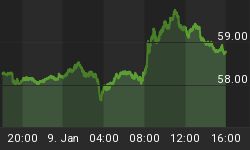Below is an extract from a commentary originally posted at www.speculative-investor.com on 25th November 2007.
In Dollar Terms
China continues to grow rapidly and consume a lot of metal in the process, but increased Chinese demand was never likely to fully offset the effects on metal prices of reduced Western-World demand stemming from the downturn in the US housing market and the debt-crisis-induced reduction in liquidity. There are three reasons for this: First, expectations of continued strong Chinese demand were already factored into current metal prices. Second, the severity of the downturn in the US housing market was NOT factored into current metal prices (an average house uses 200-300 pounds of copper and the annual rate of new housing starts in the US gas dropped from 2.1M to 1.1M over the past 20 months). Third, it would be strange, indeed, if China's growth rate were to accelerate at a time when its major export markets were slowing down and its own government was taking steps to cool-off the rampant speculation underway in the stock and property markets.
It does not surprise us, therefore, that the pattern revealed by the following chart of the Industrial Metals Index (GYX) has the look of a major top. The Index is very oversold on a short-term basis so lateral support in the 375-400 range will probably hold for now. In fact, we are expecting a counter-trend rebound -- a rebound that could complete the "right shoulder" of the major topping pattern evident on our chart -- to occur during the first few months of next year. But if we make the reasonable assumption that the current trends in housing and liquidity won't come to an end in the near future then it is also reasonable to assume that the cyclical bear market in the industrial metals sector has a considerable way to go.
We have been short- and intermediate-term bearish on the industrial metals since June-July and remain so, although in all likelihood we will soon upgrade our short-term outlook in anticipation of seasonal strength during the first half of next year.

In Gold Terms
The yield-spread (the zero-risk long-term interest rate versus the zero-risk short-term interest rate) can widen in response to rising inflation expectations, but over the past ten years the lengthy periods of widening have been primarily driven by the combination of contracting financial-market liquidity* and increasing risk aversion. On the other hand, lengthy periods of yield-spread narrowing, such as the period that began during the third quarter of 2003 and ended late last year, have been indicative of expanding liquidity as speculators became increasingly eager to "borrow short" in order to purchase relatively high-risk assets and debt.
Given what we know about gold's historical role as money and the fact that the amount of gold held for monetary/investment purposes dwarfs the amount of gold consumed each year in commercial/industrial applications, the above brief description of what drives intermediate-term trends in the yield-spread suggests that gold should fare well relative to the industrial metals when the yield-spread is in a widening trend and poorly relative to the industrial metals when the yield-spread is narrowing. The following chart comparison of the gold/GYX ratio and the US yield-spread (in this case, the 30-year yield divided by the 5-year yield) shows that what should have happened has, indeed, happened.
The trend towards a wider yield-spread will naturally be interrupted by occasional corrections, but the problems in the credit markets and the associated contraction in liquidity aren't likely to end anytime soon. We therefore think that the yield-spread is presently about 1 year into a 2-4 year period of widening, which, if so, implies that the upward trend in gold relative to the industrial metals will continue for another 1-3 years.

*Note that a contraction in liquidity is not the same as a contraction in the money supply or a fall in the rate of money-supply growth. "Liquidity" relates to the ease with which investments can be traded in size, with a highly liquid financial environment being characterised by the ability to buy and sell large quantities of relatively high-risk investments without disrupting the market.















